 |
 |
|
|
Home →
Survival →
Fire →
Fireboards
Bow Boards
by Allan "Bow" Beauchamp |
|
|
|
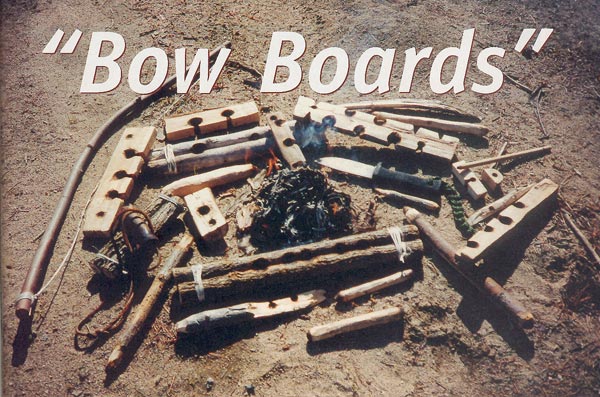
|
|
|
|
This article is on a topic with which we are all familiar -- fire by
friction, or "Fire Boards. " But are we really "familiar" with this concept?
Many articles have been written on this topic, but I am still amazed at how
little we really know about it. While in the bush one time I remember
thinking, "If I could master this, then I would truly understand the
concepts of survival and would be rid of my small survival kit."
After many hours of studying, I now have a better understanding of fire.
I will try to explain what I have learned and where it has taken me. Maybe
you will gain some insights into the fabrication of fire by friction and
also how you can develop better skills or options.
Again, I will state that I am no guru of the fire board, or fire by
friction, by any stretch of the imagination, but what I have learned has
been from nature's gifts, some research, and many cold nights looking at a
fire board and wondering "why ?" I wanted to know this skill of starting a
"Fire by Friction " which seems easy enough!
So I found a book on starting a fire this way. I looked at the
information, went into the bush, and to my amazement it didn't work! The
book says, "Just do this" and "Just do that, and the spark will jump out
into your tinder. That is all there is to it!" With this being my starting
point of attempting firing by friction on a hit-and-miss basis, I began.
First, let me tell you what I believe: the fire board is all about you.
If you have ever started fire by friction, you know. When the coal is
forming, you feel it. The method of starting fire by friction is more about
the individual than the perfectly crafted tool. I have always thought of the
fire board as we know it as not being a good option in a survival situation,
since there are too many things that can go wrong.
A few things that can go wrong are too much moisture or dampness in the
air, the wrong wood combinations, or not keeping enough torque on the
spindle to make the coal, etc. All of these plus many more have caused my
fire by friction to not develop into the coal.
I tried to find a way that would accommodate what I do in the Canadian
Bush where there are many types of weather changes. As seen in the starting
photo, I have shown some of the variations of the fire board. There are many
variations not shown, but these will help to visualize the forming of the
fire board.
The method I wish to focus on is the two stick method. |
|
|
|
Photo 1
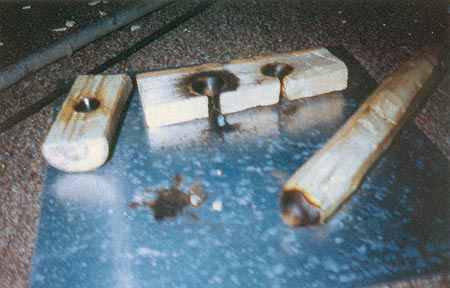 |
Photo 1 shows the
traditional method of fire by friction. This particular system
has a cedar baseboard, a willow spindle, an oak socket, and a
maple bow. There are always some preferred woods for fire by
friction, but from the example picture, don't be afraid to try
any type or any odd sizing as seen in the photo. |
|
|
|
|
Let's look at another type of fire board now. One that is better when trying
to start a fire with minimal materials at hand. This method called "Bows"
Boards is comprised of two pieces of fairly straight sticks, approximately
the size of your thumb. These can be easily snapped off of a tree, so
whether you have a knife or not, it is still a feasible option.
Join these sticks together on the long axis with whatever is available --
a piece of string, your unraveled shirt, or a shoe lace, or fashion some
fiber cordage. (If none of these are available, try finding a crack in a
rock, push the two pieces in side by side, and jam them in nice and tight.)
You have now fabricated your base board. Whatever method you use,
remember to make it tight. Being tight will have advantages. Next, break
another piece of stick off the same tree to form the spindle, or experiment
and try some other wood combinations. Fashion this with a knife, a sharp
rock flake, or just a very abrasive stone. Fashion this in the same manner
as a traditional spindle.
For the socket, try using a hollow stone, a broken piece of oak, (perhaps
the skull of a baby beaver), or another piece of hardwood to serve the
purpose. Fashion a starting hole with a sharp stone or pointed rock. Once
this is complete, a traditional bow fashioned in the usual way will be
sufficient. |
|
|
|
Photo 2
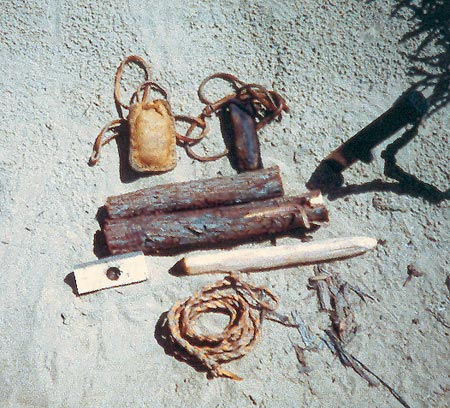 |
In Photo 2 the pieces of
this system, two sticks of cedar, a spindle made from willow, a
fashioned socket made from oak and a means to lash these
together (a piece of rawhide cordage). |
|
|
Photo 3
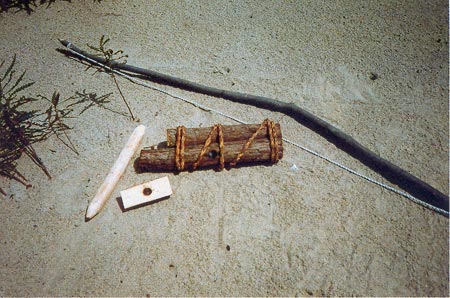 |
In Photo 3 we are looking
at the maple bow with a man-made string which will serve our
purpose here. (We will eliminate this piece later on.) In this
photo we have attached the rawhide in such a manner as to
tighten the boards to allow as much tension as could be applied.
The more tension, the better.
|
|
|
Photo 4
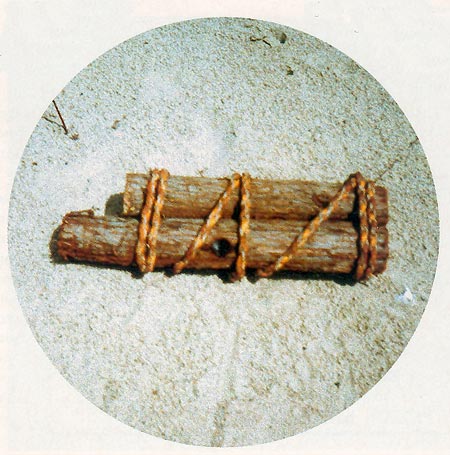 |
In Photo 4 we see a close
up of the binding of these boards. Start with this type of idea
and expand from there. |
|
|
Photo 5
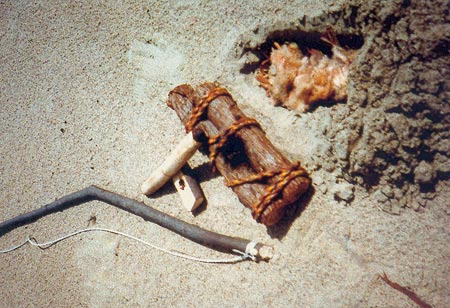 |
In Photo 5 we see that I
have started spinning my hole which is seated between the two
sticks. It really does not matter where one starts spinning. |
|
|
|
|
I like using the side of the rawhide to help stabilize the spindle. I have
noticed on occasion that this method can be slippery at first. The tinder
has been prepared in a hole with the materials to sustain the coal. I prefer
doing this on a very windy day. We have already seen that some of my choices
are not favorable with the traditional method of fire starting,. These I
feel are advantages to this method:
A. Place the fire board on the ground. (True, it is on sandy ground but
still not preferred for fire by friction, since ground moisture is always a
problem.)
B. We are doing this technique in the wind, but I will show how we can
use this to our advantage.
As seen in the photo, I have done the same procedure as with a
traditional fire board. First, I placed the spindle in between the two
sticks I have bound, held the spindle against my leg in the same manner as
one would with the traditional board, and placed my foot on the board to
stabilize it and not allow any wobble.
One advantage here again, is that with the two sticks being round, if you
had a partially moist, muddy area (and I do mean muddy area) and placed this
system in it, it would form to the bottom and hold the base of the board for
you. This will only help increase the stability. I have shown this technique
to individuals, using a partially moist, muddy area, and received a smile,
as we all know the traditional fire board put down in a muddy area will
bring much dissatisfaction. |
|
|
|
Photo 6
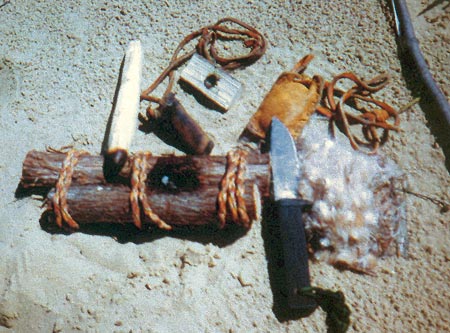 |
In Photo 6 I have continued
the spinning process. We can see that the coal is apparent. This
formed coal has been left for considerable lengths of time and
found to be not fragile. On this particular windy day with a
traditional fire board, one would not hope for wind, but I have
found that with this bow board, the wind is an advantage. With
the two sticks tied together, we have a natural channel. The
coal, as you can see, is well protected from the wind down in
the crack between the sticks. If the wind is too strong, turn
the board away from the wind, so that the wind will hit the
outer side of the sticks. |
|
|
|
|
If the coal needs a little air, turn the sticks into the wind. This allows
the wind to be channeled into the coal and helping fuel its formation. This
is a definite advantage over traditional fire boards, where individuals will
blow on their coal, and the moisture from their heavy breathing causes the
coal at times to be blown out.
Leaving this coal in the wind channel only strengthens it. The wind
strength can also be varied by just turning the board slightly, one way or
another, to increase or decrease its strengths. |
|
|
|
Photo 7
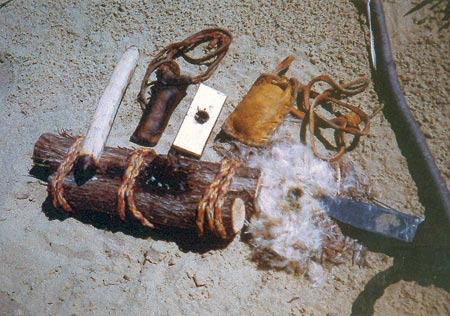 |
Photo 7 shows that after we
have spun the spindle a short while, taken the coal, and placed
it in the bundle of cattail (as seen at the tip of my knife) ,
there is still a good-sized coal still in the crack of the two
sticks. When using this method, I have often times formed two
coals-one on opposite sides of the cracks. In this particular
photo this is not the case, but it will be for you as you
develop this skill. Having two coals develop will be of great
assistance when starting a fire, as many times we have made a
coal and lose it because of some unforeseen circumstance. |
|
|
Photo 8
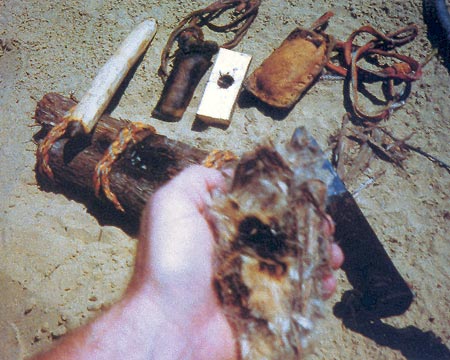 |
Photo 8 shows a close-up of
the coal, and the background shows that the coal still in the
crack is almost the same size. If you leave the coal with the
natural crack into the wind, it will develop. An advantage here
worth mentioning is that you can work with one coal, and while
the coal is forming its life, it is easy to use the side of your
knife, scratch some shavings from the cedar stick, and build
what I call my bush match. This is accomplished by allowing
the coal to grow and feed off the sticks, using the fibers for
kindling. Then use your knife to shave little strips of cedar
off the stick and build the fire in the cedar stick base board.
|
|
|
Photo 9
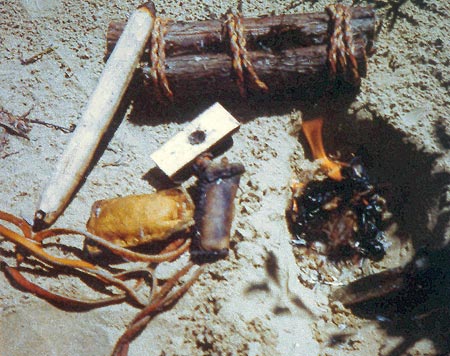 |
In Photo 9 we can clearly
see that the work has paid off. This is what we wish to
accomplish when we need to make fire by friction. This method
seems to work well. In these photos I have shown my bow board
using cedar to get the desired results. We are not limited by
this system yet.
Many individuals will say that there are preferred woods.
Well, I have a wood combination that many will say probably
won't work. One advantage with the bow boards is that what I
felt at first would not be suitable combinations seemed to work.
|
|
|
Photo 10
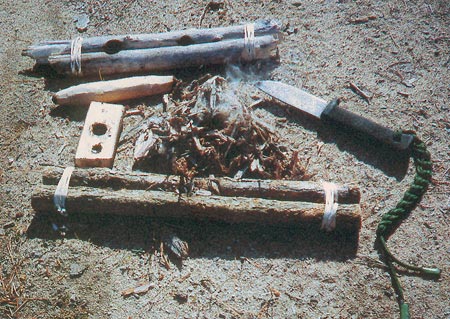 |
In Photo 10 we see two bow
boards which I have tied with white cordage to show exactly how
they were bound. They were bound differently than a rawhide tie
down. The one at the top is gray and dry. This was actually my
first attempt at the bow boards. I found a stick lying on the
ground in early fall, broke it in half, and tried it. There is a
burn mark on the stick. This worked well, and I discovered it
was a poplar tree stick. |
|
|
|
|
The other (on the bottom) was a piece of stick I cut off a small, living
tree beside a wet area. I will explain the pieces to you, and you decide.
In the same photo, the spindle was made from a piece of willow, the socket
was made from oak, and the bow was the same one from the last photos, made
of maple. Lastly, the bow board is actually oak.
Yes, I said that right -- an oak bow board. Now we have a new concept,
using a willow spindle on an oak bow board! |
|
|
|
Photo 11
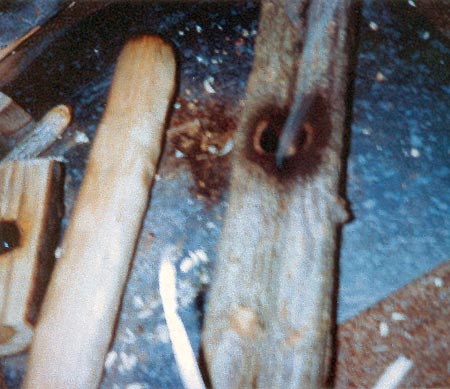 |
In Photo 11 we see that
after using my spindle a short while, we have actually started a
coal. |
|
|
Photo 12
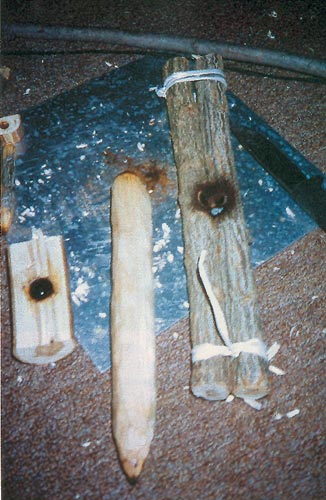 |
In Photo 12 we see the size
of this coal and its intensity. It is a well-formed coal. |
|
|
Photo 13
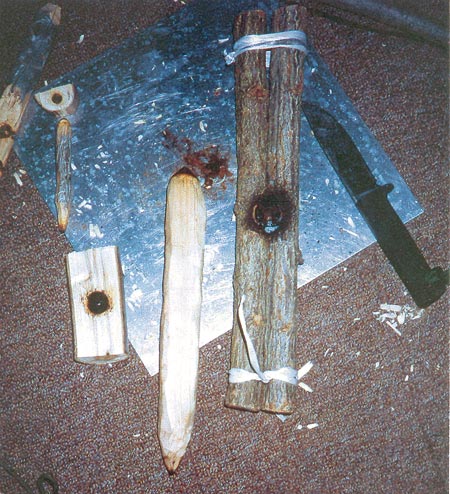 |
Photo 13 shows that not
only is it a good coal, but it is also growing, as seen in
comparing it. Look at the size of the coal in the previous
photo, and you will now see it is actually spreading to the
inner side of the crack. |
|
|
Photo 14
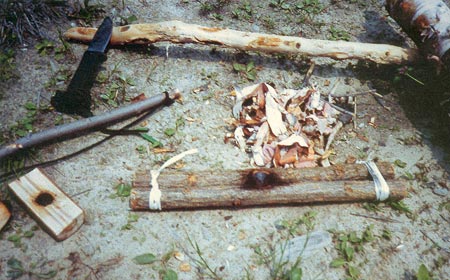 |
Photo 14 shows that this
board is actually out in the elements-placed on the ground and
not sheltered from the wind. After spinning the spindle once
again, we see the coal dust has formed, just before the coal has
developed. When you view this photo we only see one burn hole.
To keep the same sticks around a while, just give them a quarter
turn in any direction, and you now have a new piece.
|
|
|
|
|
Refer back to Photos 3 and 4. Now you know where the burn beside the
rawhide came from. You can actually get many fires from two small pieces of
sticks. |
|
|
|
Photo 15
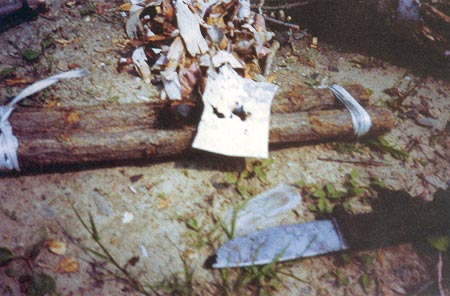 |
In Photo 15 we see that I
have now transferred that coal into a piece of waiting birch.
When you go back and view the starting photo again, if you look
under my flint rawhide pouch, you will see my oak smaller
version of the bow board. |
|
|
|
|
I find this system of using two sticks as a board very effective. Many times
I have gone out in the bush, leaving everything behind, and thought, what
could I fashion with just nothing? This means nothing man made, not even
string.
I remember a time when I was sitting around a camp fire up on the reserve
with a spiritual leader whom I work with. Around the fire were also many
natives, sitting and listening to some stories, when someone came up with
the idea to show the technique of fire by friction and understand the
meaning of fire.
There I was, sitting on the ground below the spiritual leader with a real
captive audience wanting to see fire by friction, and having a bow board
made of oak, right on the ground. If ever there was a time for a fire board
to fail, I was sure this would be the time, but I had made this bow board
myself, and spinning away I went. It did not fail me. That is why I feel
this method is not only better in a real situation when the pressure is on,
but it also has many options in your favor. It will get a better coal even
if all is not perfect (including materials or tools), as I have outlined in
my story.
Next time you are walking through the bush, and you come across a dry log
with a small crack in it, try putting your spindle in the crack and working
it. See what happens. You might be surprised! See how the process works.
Does it resemble the bow board? Or try taking the stick pieces of cedar and
finding a crack in a rock, jamming the sticks in tight. Now try your
spindle. Can you get a fire going with these? And you didn't use cordage to
bind these? Another option?
When you have learned to get a fire going this way comfortably, try
finding a mullein stock and going into the bush. Try the rock-jamming
technique using the mullein stock and a piece of raw hide (raw hide on your
thumbs, attached to the top of the mullein stalk). This will replace the bow
and spindle. Another option?
Try using the mullein stock in the crack in the log with your bow until
you can feel it better. Experiment. Try different types of wood
combinations, different wood configurations. Try taking a plug of wood that
is half the size of the spindle and see how few strokes you can use to have
a coal develop.
Can you take the string off your bow and make cordage to get the fire
going?
I have outlined an option earlier so we are not dependent on a string, or
should you wish to fabricate cordage. (My next article "Cordage" will show
some interesting things.)
Taking the time to understand any system has its own rewards, as I am
sure you have already discovered. There are many ways in which this system
can be enhanced. Try all the fire by friction techniques with this bow board
and see which ones work best for you.
I am still finding many fine ideas that have come from understanding this
fire starting technique.
There is always something to learn. Nature has so much to "teach" us, if
we are willing to listen. I hope that the time you spend trying fire by
friction is as rewarding for you as it still is for me.
Just a thought: Is it possible to take the traditional fire board and put
it in half an inch of water outside and get a fire going?
Can you go out in -30 degrees below zero and get a coal from a
traditional fire board?
Well, try your option -- the bow board!
If you follow my articles, watch from time to time, and I will add these
extra photos. Do your own experimenting and bush time, and see where nature
shows you her options. There is so much more on this topic that I can write
about, but most of the rewards will come from seeing it for yourself. |
|
|
Photographs and text on this page Copyright by Allan "Bow"
Beauchamp; used with permission of the author.
This article originally appeared in Wilderness Way magazine, Volume 6, issue
1 |
|
|
|
|
|
 |
|